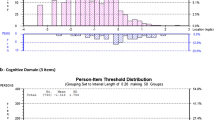Abstract
The revised Functional Assessment of Human Immunodeficiency Virus Infection (FAHI) quality of life (QoL) instrument has been updated and expanded to provide more complete and accurate coverage of human immune deficiency virus/ acquired immune deficiency syndrome (HIV/AIDS)-related QoL. Factor analysis and the Rasch measurement model were used to determine a new subscale structure for the FAHI. The content of these subscales, including physical well-being (ten items, α = 0.91), function and global well-being (13 items, α = 0.86), emotional well-being/living with HIV (10 items, α = 0.82), social well-being (eight items, α = 0.73), and cognitive functioning (three items; α = 0.75), reflect both general illness- and HIV/AIDS-specific QoL concerns: a total QoL score can also be calculated for the FAHI (44 items, α =0.91). Psychometric evaluation revealed good internal consistency reliability for the FAHI and its subscales. In addition, construct validity, known groups validity and sensitivity to change were demonstrated by significant associations between the FAHI and additional indicators of functional status, psychological symptoms, stress and illness severity. In summary, the FAHI is a psychometrically sound instrument that captures multiple important dimensions of HIV/AIDS-related QoL. It is brief, easy to administer and score, has been translated into nine languages other than English and is appropriate for use in clinical trials and clinical practice.
Similar content being viewed by others
References
Hays RD, Cunningham WE, Ettl MK, Beck CK, Shapiro MF. Health-related quality of life in HIV disease. Assessment 1995; 2: 363–380.
Tsevat J, Solzan JG, Kuntz KM, et al. Health values of patients infected with human immunodeficiency virus. Med Care 1996; 34: 44–57.
Revicki DA, Wu AW, Murray MI. Change in clinical status, health status, and health utility outcomes in HIV infected patients. Med Care 1995; 33: AS173–AS182.
Lubeck DP, Fries JF. Changes in health status after one year for persons at-risk for and with HIV infection. Psychol and Health 1994; 9: 79–92.
Cunningham WE, Bozzette SA, Hays RD, Kanouse DE, Shapiro MF. Comparison of health-related quality of life in clinical trial and nonclinical trial human immunodeficiency virus-infected cohorts. Med Care 1995; 33: AS15–AS25.
Weissman JS, Cleary PD, Seage GR, et al. The influence of health-related quality of life and social characteristics on hospital use by patients with AIDS in the Boston Health Study. Med Care 1996; 34: 1037–1054.
Cella DF, McCain NL, Peterman AH, Mo F, Wolen D. Development and validation of the Functional Assessment of Human Immunodeficiency Virus Infection (FAHI) quality of life instrument. Qual Life Res 1996; 5: 450–463.
Cella DF, Tulsky DS, Gray G, et al. The Functional Assessment of Cancer Therapy scale: development and validation of the general measure. J Clin Oncol 1993; 11: 570–579.
Cella DF, Bonomi AE. The Functional Assessment of Cancer Therapy (FACT) and Functional Assessment of HIV Infection (FAHI) quality of life measurement system. In: Spilker B, ed. Quality of Life and Pharmacoeconomics in Clinical Trials (2nd edn). New York: Raven Press, 1995: 203–214.
Zubrod CG, Schneiderman M, Frie E III et al. Appraisal of methods for the study of chemotherapy of cancer in man: comparative therapeutic trial of nitrogen mustard and triethylene thiophosphoramide. J Chron Dis 1960; 11: 7–33.
Cella DF, Jacobsen PB, Orav EJ, Holland JC, Silberfarb PM, Rafla S. Abrief POMS measure of distress for cancer patients. J Chron Dis 1987; 40: 939–942.
Strahan T, Gerbasi KC. Short homogeneous versions of the Marlowe-Crowne Social Desirability Scale. J Clin Psychol 1972; 28: 191–193.
Karnofsky DA, Abelmann WH, Craver LF, Burchenal JH. The use of the nitrogen mustards in the palliative treatment of carcinoma. Cancer 1948; 1: 634–656.
McCain NL, Gramling LF. Living with dying: coping with HIV disease. Issues Mental Health Nurs 1992; 13: 271–278.
Horowitz M, Wilner N, Alvarez W. Impact of Events Scale: a measure of subjective stress. Psychosomat Med 1979; 41: 209–218.
Wright B, Linacre M. Reasonable mean-square fit values. Rasch Measure Trans 1994; 8: 370.
Cattell RB. The Scientific Use of Factor Analysis in Behavioral and Life Sciences. New York: Plenum Press, 1978.
Rasch G. Probabilistic Models for Some Intelligence and Attainment Tests. Chicago, IL: University of Chicago Press, 1980.
Andrich, D. A rating formulation for ordered response categories. Psychometrika 1978; 43: 561–573.
Wright BD, Masters GN. Rating Scale Analysis. Chicago, IL: Mesa Press, 1982.
Wright BD, Linacre JM. BIGSTEPS: A Rasch Analysis Computer Program for all Two-facet models. Chicago, IL: MESA Press, 1997.
Wright BD, Linacre JM. BIGSTEPS: A Rasch Analysis Computer Program for all Two-facet models. Chicago, IL: MESA Press, 1993.
Linacre JM, Wright BD. Chi-square fit statistic. Rasch Measure Trans 1994; 8: 360.
Centers for Disease Control. 1993 revised classification system for HIV infection and expanded surveillance case definition for AIDS among adolescents and adults. Morbidity Mortality Weekly Rep 1992; 41.
Aaronson NK, Ahmedzai S, Bergman B et al: The European Organization for Research and Treatment of Cancer QLQ-C30: a quality-of-life instrument for use in international clinical trials in oncology. J Nat Cancer Inst 1993; 85 : 365–376.
Cella DF. F.A.C.T. Manual: Manual for the Functional Assessment of Cancer Therapy (FACT) scales. Chicago: Rush-Presbyterian-St Luke's Medical Center, 1996.
Author information
Authors and Affiliations
Rights and permissions
About this article
Cite this article
Peterman, A.H., Cella, D., Mo, F. et al. Psychometric validation of the revised Functional Assessment of Human Immunodeficiency Virus Infection (FAHI) quality of life instrument. Qual Life Res 6, 572–584 (1997). https://doi.org/10.1023/A:1018416317546
Issue Date:
DOI: https://doi.org/10.1023/A:1018416317546




